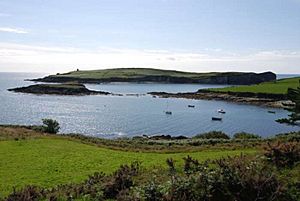Battle of Castlehaven facts for kids
Quick facts for kids Battle of Castlehaven |
|||||||
|---|---|---|---|---|---|---|---|
| Part of the Nine Years' War and Anglo-Spanish War | |||||||
 Present-day view of Castlehaven Bay |
|||||||
|
|||||||
| Belligerents | |||||||
| Commanders and leaders | |||||||
| Richard Leveson | Pedro de Zubiaur | ||||||
| Strength | |||||||
| 4 warships 2 merchantman |
6 ships Numerous shore batteries |
||||||
| Casualties and losses | |||||||
| 150 casualties | 2 ships sunk, 4 driven ashore 200 killed or wounded, 50 captured |
||||||
The Battle of Castlehaven was a naval battle that took place on 6 December 1601 in the bay off Castlehaven on the south coast of Ireland during the Nine Years' War between a Spanish naval convoy of six ships and an English fleet, commanded by Admiral Richard Leveson and consisting of four warships. The Spanish convoy was protected by fortified positions on shore, a castle, and 600 Spanish and Irish footmen. Five out of six Spanish ships, commanded by General Pedro de Zubiaur were either sunk, captured, or run aground in the battle, while the English fleet lost no ships.
Background
On 23 September 1601, a Spanish Fleet under Don Juan del Águila arrived in Kinsale harbour. Zubiaur with six ships became separated from the main fleet. Eventually Zubiar arrived with a total force of 2000 men near Castlehaven on 1 December. At that time Castlehaven Castle was held by the O'Driscoll clan and they welcomed the Spanish. On 2 December, a day after the Spanish arrived in Castlehaven, Lord Mountjoy was informed that seven Spanish ships had entered the harbour of Castlehaven. On 4 December, Mountjoy received confirmation of the story. The danger posed by the Spaniards’ arrival was immediately realized, and Mountjoy took immediate steps to strengthen English defences. The commander of the English naval forces at Kinsale, Admiral Leveson, was ordered to "seeke the Spanish fleete at Castlehaven, to take them if he could, or otherwise to distresse them as much as he might." Leveson then left his vice-admiral Preston to guard Kinsale harbour and took the rest of the fleet heavily armed to Castlehaven.
Battle
Leveson had with him four naval vessels, Warspite, Defiance, Swiftsure, and Merlin, as well as a merchantman and a caravel. The following day, the wind was blowing inland, thereby preventing the English ships from leaving. Leveson had his vessels towed out of Kinsale harbour, and he then set off for Castlehaven.
At 10 o’clock the next morning, 6 December, Leveson’s fleet arrived off Castlehaven. Zubiaur however was ready for them with an eight-gun battery at the mouth of the harbour. A Captain Fleming commanding the 10-gun Merlin rowed through Spanish fire to make a channel for the 518-ton Warspite to follow. A heavy pounding from the Spanish shore batteries and the vessels ensued which Leveson said ‘much annoyed’ him. From then until four o’clock that afternoon the two sides battled. Zubiaur's flagship galleon Maria Francesca was sunk with most hands. Another 200-ton vessel Cisno Camello was holed below the waterline and soon began to sink, and settled in shallow water. A French hire ship used for supplies was according to Leveson reduced to matchwood. Two more Spanish vessels were pounded until their crews forced them onto the rocks after sustaining continuous fire particularly from the big galleons Defiance and Warspite. Finally a Spanish merchant was boarded and captured and was found to have wheat and biscuits before being abandoned and it too being driven aground.
The Spanish were now being reinforced by more Irish foot men. Leveson's ships were running low on ammunition as they were continually returning fire. With all but one of the Spanish vessels neutralized, and with the wind blowing onshore, Leveson managed to withdraw his ships, being towed out under fire from the remaining shore batteries.
Aftermath
The fleet had suffered moderate damage; most of the time Leveson had to tow his ships to Kinsale as the wind never seemed to be in his favour. After returning, Warpsite was found to have nearly 209 cannonballs struck according to the ship's surgeon William Farmer.
Leveson had achieved a victory, neutralising Zubiaur’s naval potential. He would assist in Mountjoy's siege of Kinsale; he closed off the bay and blockaded it from the sea which was crucial to the English victory there. The Spanish garrison at Castlehaven was now cut off but distributed themselves around the area at Baltimore (Donneshed Castle), but these soon surrendered when news of the defeat at Kinsale came through. Pedro De Zubiaur made his way back to Spain and was arrested for his responsibilities but later released.

